Developer Insights
Join millions of viewers! Our engineers craft human-written articles solving real-world problems weekly. Enjoy fresh technical content and numerous interviews featuring modern web advancements with industry leaders and open-source authors.
![Quo v[AI]dis, Tech Stack? cover image](https://images.ctfassets.net/zojzzdop0fzx/28QIo74U7Nh8vFgxM7zrlJ/8b97153a1641a96380c6e9bfa32c1f95/Quo_v-AI-dis__Tech_Stack.png?fm=webp&w=3840&q=75)
Quo v[AI]dis, Tech Stack?
The article explores how AI is no longer just speeding up coding - it’s actively reshaping the choices we make as developers. From self-reinforcing loops around popular stacks like React and Node.js to AI-generated apps....
Aug 7, 2025
11 mins

Roo Custom Modes
Roo Code is an extension for VS Code that provides agentic-style AI code editing functionality. You can configure Roo to use any LLM model and version you want by providing API keys....
Jun 13, 2025
6 mins

What Sets the Best Autonomous Coding Agents Apart?
Autonomous coding agents are no longer experimental, they are becoming an integral part of modern development workflows, redefining how software is built and maintained....
Jun 3, 2025
4 mins
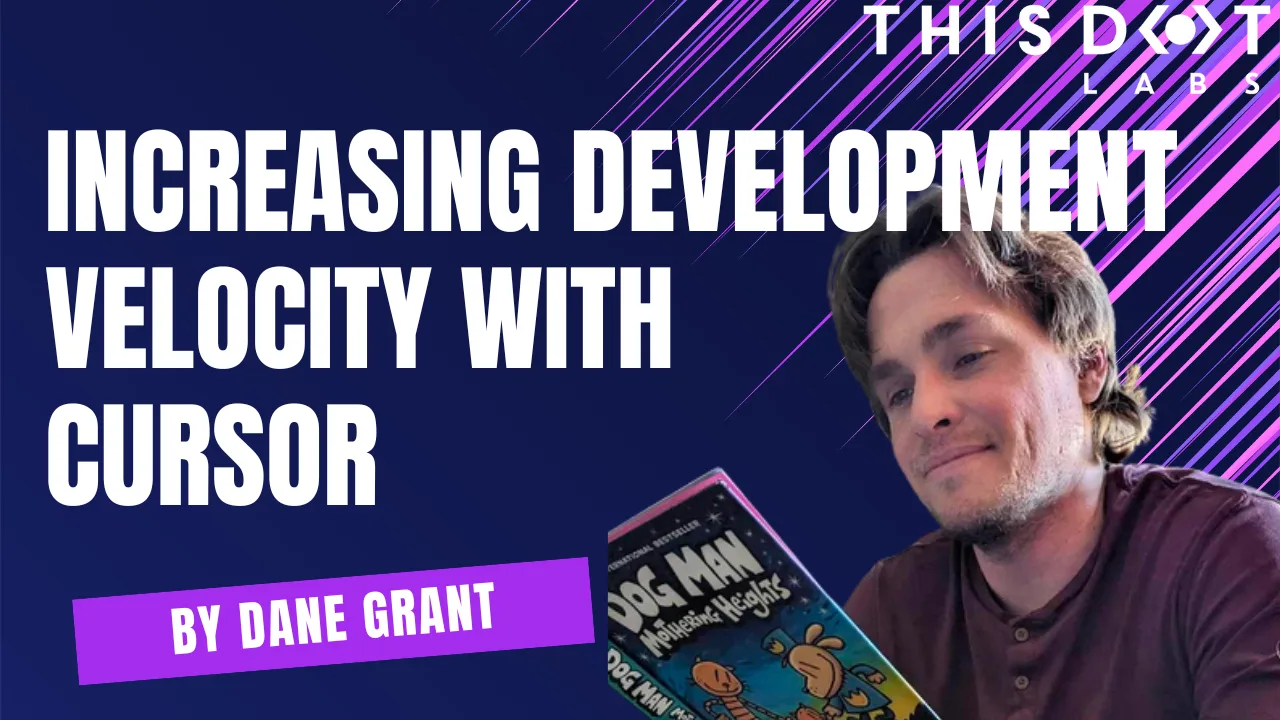
Increasing development velocity with Cursor
Boost your coding efficiency with Cursor, an AI-powered VSCode fork. Learn how features like Autocomplete, Ask, and Agent can streamline development, automate tasks, and enhance productivity....
Apr 18, 2025
11 mins
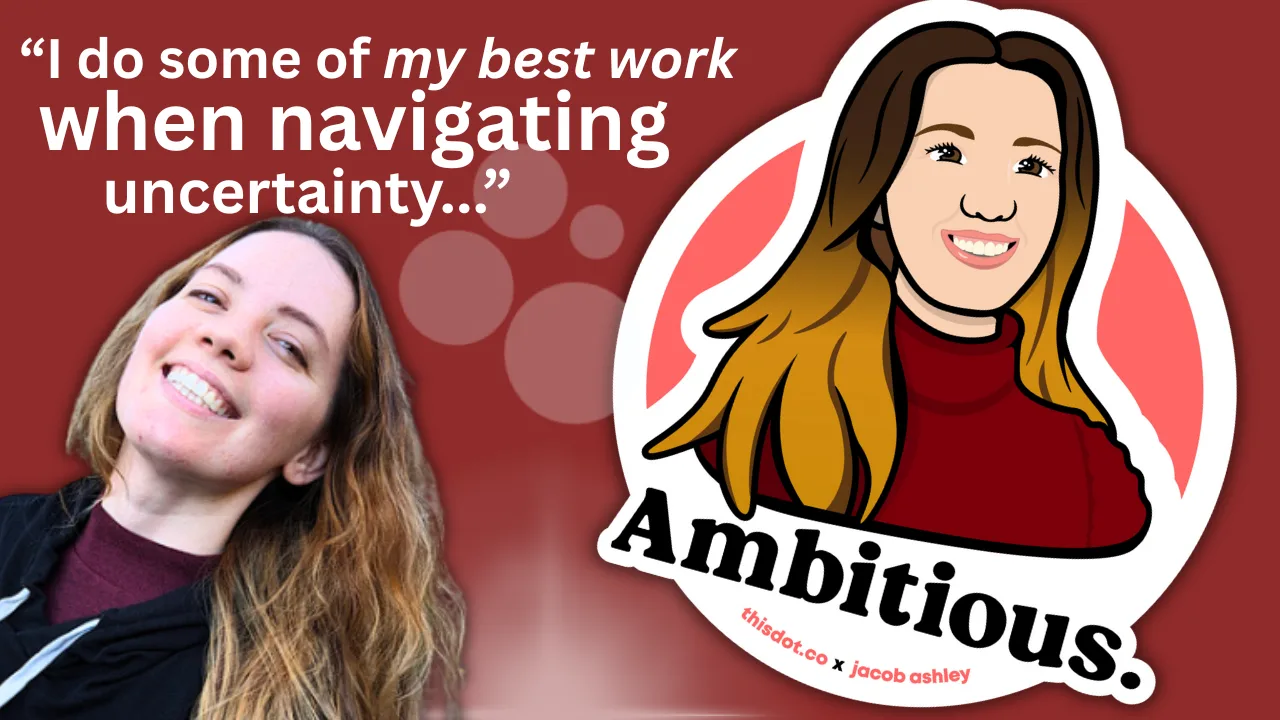
“Recognize leadership behavior early. Sometimes people don’t even realize it in themselves…” Kelly Vaughn on Product Leadership, Creating Pathways for Women in Tech, & Conferences
Some leaders build products. Some lead engineering teams. Kelly Vaughn is doing both. As Director of Engineering at Spot AI—a company building video intelligence software—Kelly recently expanded her role to oversee both Product and Engineering for their VMS offering. That shift means juggling strategy, execution, and team development, all while helping others step confidently into leadership themselves. And yes, she still finds time to speak at conferences and answer DMs from people navigating the same transitions she once did. We spoke with Kelly about spotting leadership potential early, why ambiguity doesn’t have to feel chaotic, and the lesson she learned the hard way about managing up. Stepping into Product Leadership Kelly’s new title might look like a promotion on paper, but the shift is more philosophical than anything. > “Engineering leadership is about execution,” she says. “Product leadership is about defining why we’re building something in the first place.” Now leading Product and Engineering for Spot AI’s VMS product, she’s talking to customers, researching market trends, and making smart bets on where to invest next. It’s a role she’s clearly energized by. > “I’m really looking forward to dedicating time to shaping our product’s future.” Thriving in Ambiguity Some people panic when problems are fuzzy or undefined. Others use it as fuel. > “There are two key traits I see in people who handle ambiguity well,” Kelly says. “They stay calm under stress, and they know how to form a hypothesis from a vague problem statement.” That means asking the right questions, taking action quickly, and being totally okay with pivoting when something doesn’t pan out. It’s no surprise that these same traits overlap with great product thinking—a mindset she’s now leaning into more than ever. > “I do some of my best work when navigating uncertainty,” she adds. Read Kelly’s blog on embracing ambiguity in Product! Creating Leadership Pathways for Women in Tech When asked how leaders can create more leadership pathways for women in software engineering, Kelly stressed that it is not a passive process. > “Senior leaders need to be proactive,” Kelly says. “That starts with identifying and addressing bias across hiring, promotions, and day-to-day interactions.” She emphasizes psychological safety—so women feel confident advocating for themselves and others. But she also knows not everyone feels ready to raise their hand. > “Don’t wait for someone to ask for a title change or a growth opportunity. Recognize leadership behavior early. Sometimes people don’t even realize it in themselves yet.” On Stage, In Real Life Kelly’s no stranger to the tech conference circuit—often giving talks on engineering leadership and team growth. Her biggest source of inspiration? Conversations with people trying to make the leap into leadership. > “I might use the same slide deck at three conferences,” she says, “but the talk itself will be different every time.” Rather than sticking to a script, she likes to share recent examples from her own work, tailoring the delivery to the audience in front of her. It keeps things relevant, grounded, and never too polished. Between setting product strategy, mentoring the next generation of leaders, and hopping from one tech conference to the next, Kelly Vaughn is showing what it means to lead with clarity—even when things are unclear. She’s not here to tell you it’s easy. But she will tell you it’s worth it. Connect with Kelly Vaughn on Bluesky. Sign up for Kelly Vaughn’s Newsletter! Sticker Illustration by Jacob Ashley....
Apr 4, 2025
3 mins
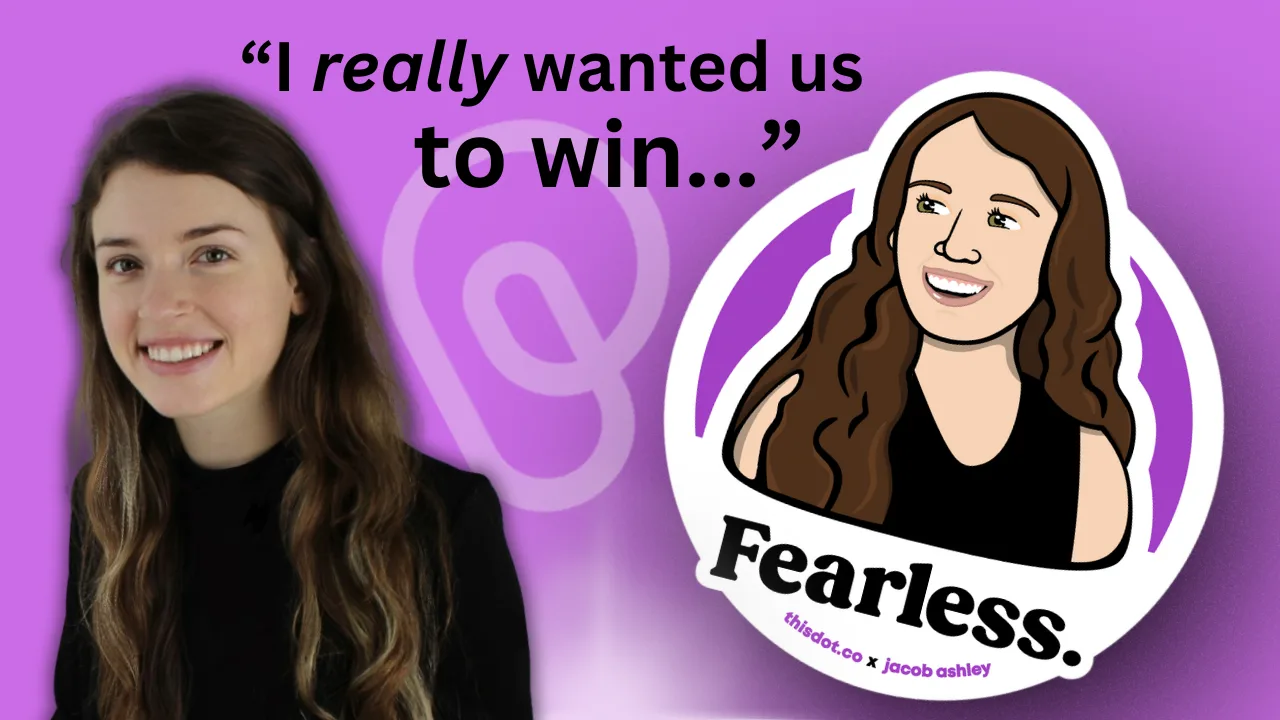
“It Sounds a Little Dystopian, But Also Kind of Amazing”: Conversations on Long Term AI Agents and "Winning" Product Hunt with Ellie Zubrowski
Ellie Zubrowski doesn’t walk a traditional path. In the three years since graduating from a university program in Business Administration, she biked across the U.S., studied Kung Fu in China, learned Mandarin just for fun, and completed the #100DaysOfCode challenge after deciding she wanted a career switch. That same sense of curiosity and willingness to jump into the unknown now fuels her work as a Developer Advocate at Pieces, where she leads product launches, mentors job seekers, and helps developers learn how to best leverage Pieces’ Long-Term Memory Agent. Her journey into tech was guided not just by a want to learn how to code and break into the industry, but by a fascination with the structure of language itself. > “There are so many parallels between human languages and programming languages,” she says. “That realization really made me fall in love with software.” > We spoke with Ellie about launching a #1 Product Hunt release, her predictions for AI agents, and why conferences don’t have to break your budget. Launching LTM-2 to the Top of Product Hunt Recently, Ellie led the launch of Pieces’ Long-Term Memory Agent (LTM-2), which took the top spot on Product Hunt—a major win for the team and their community. > “I’m super competitive,” she admits. “So I really wanted us to win.” The launch was fully organic—no paid promotions, just coordinated team efforts, a well-prepared content pipeline, and an ambassador program that brought in authentic engagement across X, Discord, and Reddit. She documented their entire strategy in this blog post, and credits the success not just to good planning but to a passionate developer community that believed in the product. Following a successful performance at Product Hunt, Ellie is committed to keeping Pieces’ user community engaged and contributing to its technological ecosystem. > “Although I’m still fairly new to DevRel (coming up on a year at Pieces!), I think success comes down to a few things: developer adoption and retention, user feedback, community engagement, and maintaining communication with engineering.” Why AI Agents Are the Next Big Thing Ellie sees a major shift on the horizon: AI that doesn’t wait for a prompt. > “The biggest trend of 2025 seems to be AI agents,” she explains, “or AI that acts proactively instead of reactively.” Until now, most of us have had to tell AI exactly what to do—whether that’s drafting emails, debugging code, or generating images. But Ellie imagines a near future where AI tools act more like intelligent teammates than assistants—running locally, deeply personalized, and working in the background to handle the repetitive stuff. > “Imagine something that knows how you work and quietly handles your busy work while you focus on the creative parts,” she says. “It sounds a little dystopian, but also kind of amazing.” Whether we hit that level of autonomy in 2025 or (likely) have to wait until 2026, she believes the move toward agentic AI is inevitable—and it’s changing how developers think about productivity, ownership, and trust. You can read more of Ellie’s 2025 LLM predictions here! The Secret to Free Conferences (and Winning the GitHub Claw Machine) Ellie will be the first to tell you: attending a tech conference can be a total game-changer. “Attending my first tech conference completely changed my career trajectory,” she says. “It honestly changed my life.” And the best part? You might not even need to pay for a ticket. > “Most conferences offer scholarship tickets,” Ellie explains. “And if you’re active in dev communities, there are always giveaways. You just have to know where to look.” In her early days of job hunting, Ellie made it to multiple conferences for free (minus travel and lodging)—which she recommends to anyone trying to break into tech. Also, she lives for conference swag. One of her all-time favorite moments? Winning a GitHub Octocat from the claw machine at RenderATL. > “She’s one of my prized possessions,” Ellie laughs. Proof here. 🐙 Her advice: if you’re even a little curious about going to a conference—go. Show up. Say hi to someone new. You never know what connection might shape your next step. Ellie’s Journeys Away from her Desk Earlier this year, Ellie took a break from product launches and developer events to visit China for Chinese New Year with her boyfriend’s family—and turned the trip into a mix of sightseeing, food adventures, and a personal mission: document every cat she met. (You can follow the full feline thread here 🐱) The trip took them through Beijing, Nanjing, Taiyuan, Yuci, Zhùmǎdiàn, and Yangzhou, where they explored palaces, museums, and even soaked in a hot spring once reserved for emperors. > “Fancy, right?” Ellie jokes. But the real highlight? The food. > “China has some of the best food in the world,” she says. “And lucky for me, my boyfriend’s dad is an amazing cook—every meal felt like a five-star experience.” What’s Next? With a YouTube series on the way, thousands of developers reached through her workshops, and an eye on the next generation of AI tooling, Ellie Zubrowski is loving her experience as a developer advocate. Follow @elliezub on X to stay in the loop on her work, travels, tech experiments, and the occasional Octocat sighting. She’s building in public, cheering on other devs, and always down to share what she’s learning along the way. Learn more about Pieces, the long-term LLM agent. Sticker Illustration by Jacob Ashley...
Mar 28, 2025
4 mins

“ChatGPT knows me pretty well… but it drew me as a white man with a man bun.” – Angie Jones on AI Bias, DevRel, and Block’s new open source AI agent “goose”
Angie Jones, VP of Developer Relations at Block, champions developer advocacy, AI ethics, and leadership. She’s leading discussions on AI governance, bias in career tools, and *goose*, an open-source AI assistant for developers....
Mar 13, 2025
4 mins
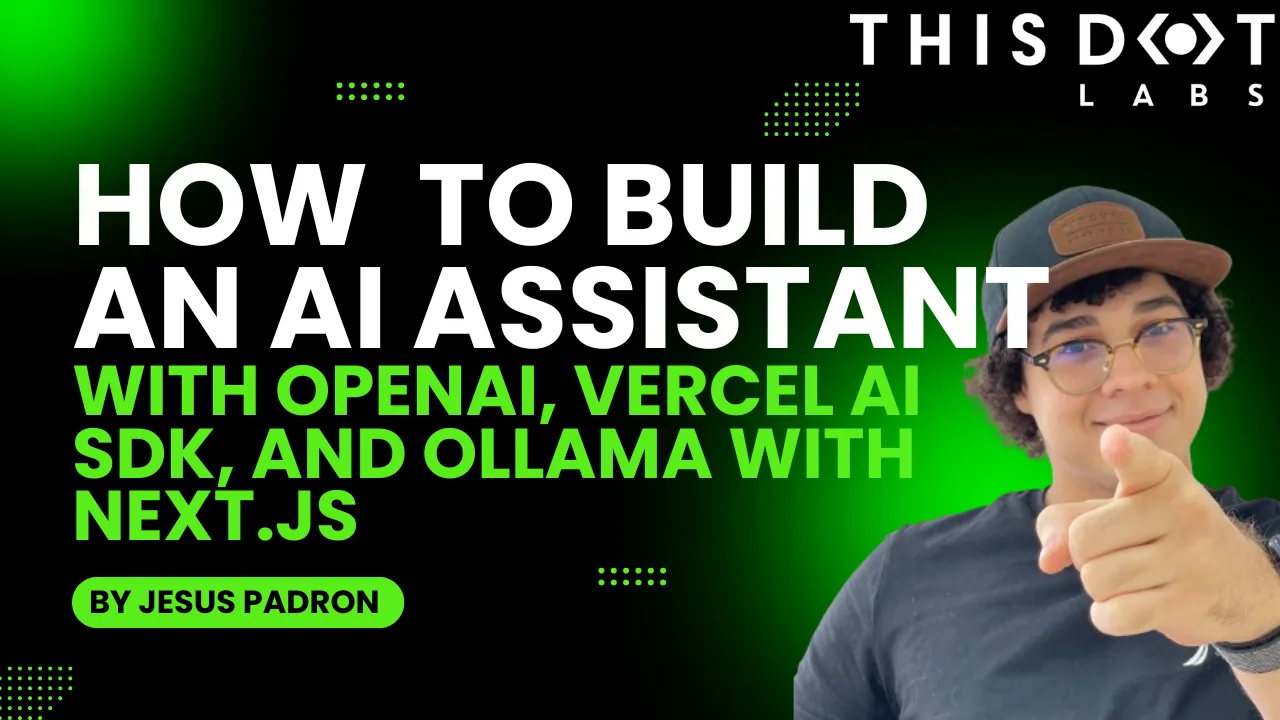
How to build an AI assistant with OpenAI, Vercel AI SDK, and Ollama with Next.js
Learn how to run Llama 3.1 locally in a Next.js app, send audio to it, and play responses back to users....
Sep 27, 2024
8 mins

ChatGPT can't solve these problems! with Chris Gardner
Chris Gardner talks neural networks, covering fundamental concepts, historical development, and practical applications. It’s important to understand the difference between artificial intelligence (AI) and machine learning, and the role of neural networks in solving intricate problems with vast datasets. This conversation centers around the intricacies of training neural networks, particularly as they become more complex with multiple layers. Chris and Rob touch on the fascinating yet daunting nature of neural networks, discussing their ability to learn beyond human comprehension. Turning to the practical side of using neural networks, Chris shares the existence of libraries that exist to simplify the process of building a network, enabling users to input data, specify parameters, and entrust the system with the training. Both caution about the biases inherent in the data and the responsibility associated with working on machine learning models. They address challenges related to ethics, highlighting the difficulties in identifying biases and emphasizing the delicate balance between excitement and caution in the evolving field of machine learning. Listen to the podcast here: https://modernweb.podbean.com/e/chris-gardner/...
Jan 16, 2024
1 min

Let Purpose Drive Your Artificial Intelligence Transformation
From administrative and analytics tasks present in nearly every industry, to niche processes that serve only a handful of businesses, the diversity of how we apply Artificial Intelligence grows, seemingly by the moment. And with it, the size of the market is exploding. In fact, less than half a decade ago, this market was valued at $644 million, and half a decade from now, it is expected to be worth nearly $118 billion. When discussing the growth of AI, many have a hard time separating it from the advancement of AI. While the latter will naturally follow the former, the vast majority of companies that are integrating, and expanding the size of this market, will be in a constant state of catching up to some of the world’s foremost leaders in AI advancement. And I’m here to tell you, that’s okay. Because, as the growth of the AI market continues, the diversity in humans that will use it, and human demand that will be met by it, will grow too. And your responsibility as an executive or leader is not necessarily to push the envelope of AI, or discover the next game changing function at which the world can marvel; it is to meet the needs of the humans, be they your employees or customers, who will benefit from your integration. Of course, this is a very exciting time in the history of advanced digital technologies. Despite how far we have come, when we consider the potentially unending future of this transformative technology, we realize that AI is still in its infancy. As such, we often approach from a performance advancement mindset. However, if you confine your definition of performance to objective technical metrics, you may find yourself perpetually pursuing faster load times, smaller bundle sizes, and more impressive features. This may work out for your team if you have an unending line of investors, or get incredibly lucky. But even some of the biggest companies that neglected to first think of their user experience above all else have found themselves victims of Icarian pitfalls that have shelved their projects, depleted their financial resources, and denied users of products that they need. I do want to note, however, that the focus of this article isn’t to suggest that we shouldn’t strive to advance our understanding of the “nuts and bolts” of AI and other transformative digital technologies. But it’s time to make tough decisions about your company’s place in the AI marketplace. Do you have the budget, the demand, or a responsibility that requires you to implement the most cutting edge technologies available to the market? The answer for most companies is, no. For many, their future with AI is a continual, and incremental process of meeting the minimal needs of their customers, employees, or processes. And I am here to say that not only is this okay, but it’s a good thing. In this article, I implore you to look at AI as a tool for promoting human excellence and experience, and rethink what it means for AI technology to be “performant”. Ultimately, I want you to feel inspired and empowered to begin your digital transformation voyage by placing people and purpose at the helm. RETHINKING PERFORMANCE According to leading educational non-profit Autism Speaks, 1 in every 59 children born today will fall somewhere on the autism spectrum. Although symptoms are diverse, many individuals with this diagnosis struggle with normative social conventions in a manner that impacts their daily lives. Due to advancements in our understanding of autism, it’s now typically diagnosed in early childhood, tasking many parents with the responsibility of helping their children navigate a world that better accommodates neurotypical behaviors. Laura Krieger is one of these parents. Matthew, her eight year old son, has autism, and struggles to read others’ emotions. The pair were featured in a PBS Newshour segment on Brain Power, a company founded by award winning neuroscientist and entrepreneur, Ned Sahin. Brain Power’s product is a Google Glass aided software that utilizes both AI and augmented reality technologies to help kids with learning differences build skills such as identifying emotions, and maintaining eye contact, through play. When Krieger plays one of these skill building games with her son, she can’t help but break out in tears, saying she feels like he can truly see her for the first time. Krieger is not responding to just how low the latency of the codebase powering the software is, or whether its deploying the latest architectural concepts. She likely doesn’t care whether the software was created using Amazon Web Services, TensorFlow, or a proprietary system. What she does care about is getting the chance to connect with her son in a way she never thought possible. And when we look at Brain Power through the eyes of children who use it, we see its strength in its mode of education. Rather than running users through drills or lesson plans, it rewards them through collaboration, natural interaction, and a gamified points system. When you see the children using the system, they aren’t marveling at the natural feel of the interface that betrays its complexity. They’re simply having fun. This is the type of performance for which we should strive. THE CASE OF WATSON FOR ONCOLOGY In 2013, IBM launched a partner project with The University of Texas MD Anderson Cancer Center to create a “Watson for Oncology” software that would help doctors identify and prescribe courses of action for cancer treatment. After pumping $62 million dollars into the project, MD Anderson officially shelved it in 2017, halting their pursuit of a cure for cancer. But the problem wasn’t a technical one. That’s to say, it was not found within the codebase. It was with the data being processed by it. The reason that MD Anderson pulled the plug on the project, which would eventually be revealed by StatNews after reviewing internal slide decks from MD Anderson, was that the program was prescribing “unsafe and incorrect” treatment plans to real patients after the product had been sold to hospitals around the world. Anderson sourced the problem back to IBM engineers and New York City-based Memorial Sloan Kettering Cancer Center, who were responsible for training Watson for Oncology. It was later discovered that their ML training process relied on a relatively small collection of hypothetical oncological cases rather than using actual patient data. Of course, we cannot presuppose intent. I am of the opinion that IBM and Kettering truly wanted to provide a product that would revolutionize oncology treatment, and save lives. But it is hard to imagine a reason why a company creating a product meant to help doctors treat their patients in the field, would not have trained their AI software with data produced by doctors working with actual cancer patients. So after indefinitely stopping this project, MD Anderson had exchanged $62 million, and four years of its time, to create a product that may have reflected some of the most advanced technical concepts available at that time, but is completely useless, in its current form, for the purpose it was meant to serve. Imagine where we could be, how many lives could have been saved or prolonged, and how much money would have been saved, in the nearly three years since this product was pulled, if developers had placed equal focus on their users and the purpose of their product as they did the technical elements. MEETING NEEDS *“As researchers, we make decisions about what our AI systems can do. It may not necessarily be optimal. It may not be necessarily efficient if you look at all of the metrics… but it may be optimal with respect to the human… which means that the system works.”* - Ayanna Howard, Ph.D Chair, School of Interactive Computing Georgia Institute of Technology Kaden Bowen of Lincoln, Nebraska shares his father’s passion for cars. Though he is non-verbal due to cerebral palsy, he asks his father, James, to “go for a ride”, multiple times a day with the help of a digital talkboard. James dreamed of taking his son on a roadtrip in a vehicle that was more stylish and fun than their wheelchair-accessible van. He searched high and low for a sporty car that he could modify to at least allow him to store a foldable wheelchair, until he realized that the hatchback of a standard Corvette might just be big enough for one. Two weeks later, the duo took a 728 mile round trip to the Corvette museum in Bowling Green, Kentucky in their brand-new (to them) Corvette, which came standard with a trunk big enough for Kaden’s chair. The Bowens don’t seem to over-complicate the accommodations that they have put in place for their son. To help increase his level of independence, they outfitted their home with Amazon Echo devices that are sensitive enough to understand the commands that are programmed into Kaden’s talkboard. Using a combination of the two technologies, Kaden can do a lot on his own. He can call his parents on the phone, stream videos on Netflix, and operate lights. It seems so obvious, but it really is quite inventive. Sure, one day we will have widely accessible neural link technology that will allow Kaden to circumvent the talkboard, and do so much more than what is permitted by an Echo. But just like his dad’s Corvette, that comes standard with enough storage space, sometimes, the best fixes are the best fixes because they are available, and they work. The technologies that Kaden uses may not boast the best metrics, feature the most jaw dropping functions, or offer the most direct route to helping him achieve increased independence. I’m sure that the communication between the talkboard and the Echo device is not always perfect. But the combination of these two relatively affordable, and accessible technologies have given Kaden more autonomy with reliable, usable services, and that, in and of itself, *is* high performance. AI INITIATIVES ARE FAILING These past few years have proven to be extremely exciting for AI technologies, and businesses are responsive, with a 2019 Gartner report showing that 37% of the nation’s leading enterprises are or are shortly planning to integrate some form of AI into their products or processes. This percentage reflects a 270% growth in that statistic when compared to research conducted in 2015. And this proportion bumps up to 62% when we look at Supply Chain and Logistics, and reaches nearly 80% when discussing the Healthcare industry. But these awe-inspiring stats come with troubling predictions that, through 2020, roughly 80% of enterprise AI programs will remain in a limbotic state of development due to their inability to properly scale with their organizations. In essence, we may be creating fabulous algorithms, with wildly impressive features and functions that may become little more than multi-million dollar proof-of-concepts. And this might be okay for some businesses who have the resources to pursue multiple avenues and digital transformation. But I am of the belief that most companies that have yet to enter AI space by now will depend on a significant ROI from the programs that they start over the next few years. For these companies, it is imperative not only to balance resources, and create realistic time-frames for integrating and/or shipping their products, but to stay diligent against the propensity for AI programs to become isolated within an organization. With all of the buzz around AI, and the seemingly endless supply of jaw dropping products and services coming out of the world’s foremost information technology companies, it’s natural that smaller programs want to keep up with the Joneses. It is, therefore, the responsibility of executives, and others in business development roles, to remain involved with their AI development programs to ensure that products and services do not outpace the demands and capacities of their customers or businesses. WORKING SYSTEMS *“The current wave of Artificial Intelligence is going to hit a peak inside of the enterprise. But when it does, it’s not going to be a monumental revolution of technology, but rather a monumental revolution of people.”* - Traci Gusher Partner, US Leader- Artificial Intelligence Analytics and Engineering, KPMG There is a lot of chatter about the need for enterprises to integrate AI powered technologies into their workflows, and products. Anxiety about the need to introduce this transformative technology is warranted. Products like Alexa, Siri, and Echo Dot are changing consumer expectations, while Forrestor predicts that, in 2020, 25% of Fortune 500 companies will include AI building blocks in their automated processes. From product to process, AI is infiltrating nearly every sect of business. That being said, it is a mistake for companies to rush an AI program without first internalizing and developing concepts of how the resulting products will better the lives or capacities of those who will use it. I get it. It’s so tempting to want to patent the next game changing system or algorithm, but if your customers, users, or employees, could be equally, if not better served by a simpler system, or another company’s proprietary tools, what is the point? Is it 100% necessary that your business be on the cutting edge of Artificial Intelligence? Will it truly better your products, services, workflows, or customers? AI has such an amazing capacity to enrich the human experience, be that personal, or professional. We overemphasize minute technical details without giving that same attention to the aspects of user needs, and experience at our own peril. Don’t feel the need to push the boundaries of our understanding of transformative technologies simply to implement your own products and services. All you need is something that sees your user, empowers them, strengthens their skills, and most importantly, works. Ready to begin your digital transformation journey, but don’t know how to start? Don’t hesitate to reach out to the team at This Dot Labs by emailing hi@thisdot.co....
Feb 21, 2020
10 mins

Financial Data Security 2020: How Banks Can Leverage AI to Detect and Prevent Fraud
As the volume of data grows and becomes more integral to daily and long term enterprise operations, the need to secure that data, and identify potential threats to it has never been more important. Cybercrimes are on the rise, with supply chain attacks up 79%, and reports of malicious PowerShell scripts increasing 1000%, in 2019 alone. A snapshot of 2018 fraud statistics presented by the FTC shows that the total identified fraud losses for individual Americans was about $1.48 billion, with the median loss per reportant equaling $375. And these statistics only reflect a portion of the 1.4 million total known instances of fraud, 75% of which did not result in any financial loss. For institutions, fraud threats can be financially devastating, resulting in losses due to theft, misrepresented financial reports, settlement costs and legal fees, operational disruption, and damaged customer and business relationships. Fraudsters are leveraging powerful, and widely available tech tools to mine businesses and individuals for important data with malicious intent, and it is incumbent that financial institutions apply the most advanced tech tools for combatting this. Promoting Customer Security with AI Most financial institutions use rule-based algorithms for alerting and blocking the potentially fraudulent transactions within all customer accounts. While this method has long been a sufficient mode of identifying fraudulent spending, the advancement of the digital age, and the expansion of mobile banking, means that individuals are keeping their money in a growingly diverse number of places, and routinely make transactions all over the world from single locations. This change has made it difficult for companies to employ one-size-fits-all predictive models to secure all customer accounts, since the diversity in user profiles and legitimate financial behaviors has outgrown them. Artificial Intelligence, however, is making it possible for financial institutions to create dynamic user profiles that track the behavior of individual account holders, and tailor fraud markers to their unique spending patterns. Kount, one company that has deployed its own proprietary AI model, for example, has found that their payments fraud detection accuracy has doubled when compared to predictive models, all the while maintaining a response rate of less than half a second. Implementing a successful AI fraud detection solution not only increases the volume of accurate detection, but decreases the instances of false positives, saving financial institutions the time and resources expended on human fraud analysis, falsely frozen accounts, and the need to constantly update predictive models. Protecting Data in the New Digital Age In late 2019, RiskedBased Security released a mid year report claiming that 2019 was on track to be the worst year for breach activity, with over 4.1 billion records compromised in the first 6 months. When we look at the total number of exposed records that same year, 61.7% belonged to financial institutions, including American Express, Suntrust, Capital One, Discover, and Lincoln Financial. Although falling victim to only 6.5% of all reported security breaches, financial companies tend to be most devastated by attacks due to the volume, variance, and sensitivity of their records when compared to that of other businesses. In the advanced digital age, data is not only crucial to protect for the interest of your customers, but also to prevent the distribution and corruption of information used to propel crucial operational decisions. Companies do not only have the responsibility to protect their customers against identity theft and fraudulent spending, but must also promote their own interests by safeguarding their most valuable digital assets. Financial institutions are massive, and as newer technologies are introduced alongside more antique, but nonetheless useful software and hardware, the challenge of protecting sensitive information at scale grows with every passing day. And just as our technologies are diversifying, so too are the threats against it. By implementing AI technologies, companies no longer need to develop seemingly endless and rapidly evolving solutions to potential security threats. Instead, companies can mobilize their existing data to create or implement intuitive softwares, able to identify real time security threats, and take appropriate action both with and without human intervention. How to Start Your AI Journey in 2020 According to IDC predictions, worldwide AI spending in 2019 was expected to be 44% higher when compared to data from the previous year. Further analysis also suggests that the banking sector is the second highest AI investor, with total spending believed to fall around $5.6 billion. With the emergence of blockchain technology threatening to dramatically revolutionize the banking sector, financial services companies will need to maintain their appeal to individuals and enterprises by leveraging their data to create more secure, performant products, services, and experiences. AI’s use in promoting data security is only one of the myriad applications of this transformative asset, expected to drive global trade operations as we enter a new era of advanced digital technologies. AI and Machine Learning are both tools that financial institutions must use to improve customer experiences, uncover novel business opportunities, and drive the direction of their future operations. The journey to full digital transformation is one of small, incremental steps. Financial services companies interested in AI integration do not have to start by creating full fledged, proprietary security systems, but can invest in future success by preparing their data, and implementing a simple AI based foundation for handling internal functions before ramping their technologies up to handle more critical aspects of their enterprise operations. Take this opportunity to set your company up for success as our digital capabilities grow both in capacity and necessity for modern global trade. By working with This Dot Labs, financial institutions learn more about how AI can support their unique operational needs, plan a pathway for its place in their future technical programs, and even start implementing some of the world’s most cutting edge technologies into your daily workflows....
Jan 29, 2020
5 mins
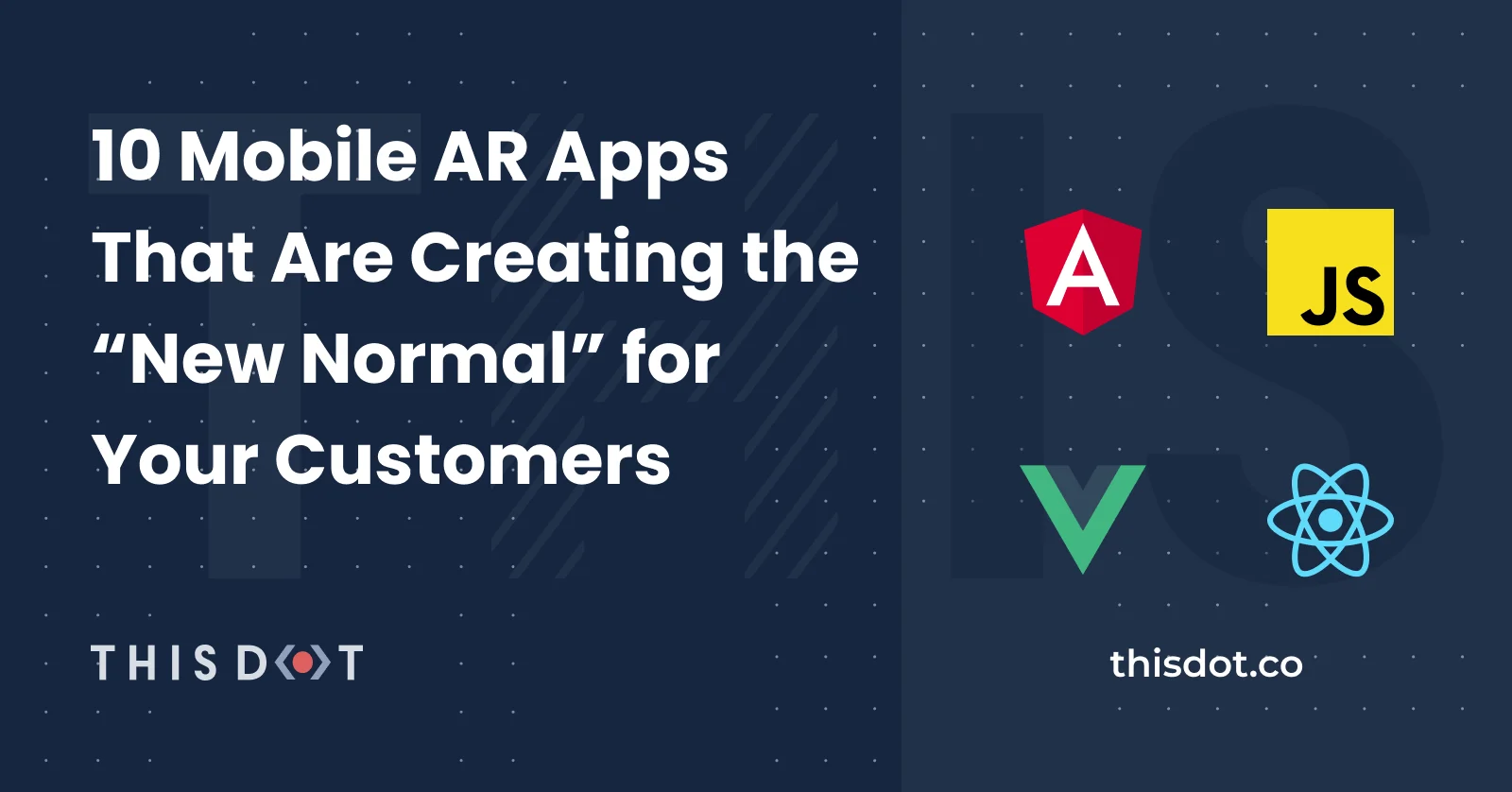
10 Mobile AR Apps That Are Creating the “New Normal” for Your Customers
Check out these 10 AR integrated mobile apps that are changing not only the way consumers interact with the physical world, but also their expectation for mobile app performance....
Jan 7, 2020
7 mins
Let's innovate together!
We're ready to be your trusted technical partners in your digital innovation journey.
Whether it's modernization or custom software solutions, our team of experts can guide you through best practices and how to build scalable, performant software that lasts.